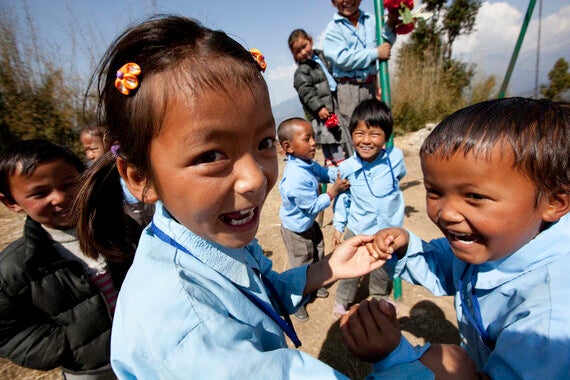
There is a village in Nepal where there are no adolescent girls, because they have all been trafficked into the worst kinds of labour in big cities or abroad.
Two years ago, Childreach International started to conduct research in one particular region of Nepal where trafficking was on the increase and where there were reports of one village with no adolescent girls living there at all, which our research has confirmed. The issues around why and how children were being trafficked are complex and multi-dimensional.
Families are torn apart by their children being trafficked, especially if the child chooses to go willingly. But why would a parent agree to send their child away with a trafficker or an agent, and why would a child choose to go? In most instances, parents are tricked into believing that their children will have a better future. Children believe the same, having been convinced they will be able to help their families by sending money home. There is an overwhelming sense of hopelessness among the girls concerning their inability to make a living or earn money. Disturbingly, this trend is accepted amongst the community.
Parents who have been manipulated into sending their children away for foreign employment are often unaware of the terms and conditions of the work their children would be forced to carry out. Many parents are under the impression that their children would be treated well as domestic help, when in fact domestic workers face regular abuse, and many of the girls are forced into prostitution instead. In many instances traffickers are extended family members or friends who are trusted by the parents.
And NGO worker in Nepal told us that traffickers have various ways of luring girls from the community to accompany them. Once, she noticed a helicopter had landed in the village. At first she thought that a political leader had come to visit the area. To her surprise, two girls disembarked and within two hours a group of girls boarded the helicopter before it left the village. It goes to show how resourceful the traffickers are and how organised and well-financed the trafficking industry is by wealthy and powerful crime lords and political patrons. According to the International Labour Organisation (ILO) forced labour generates $150 billion illegal profits each year.
While we were researching the issue of child trafficking in Nepal, the makers of a Hollywood film about child trafficking called Sold contacted us. Starring Gillian Anderson and with Emma Thompson as the Executive Producer, Sold tells the story of Lakshmi, a thirteen-year-old Nepali girl who is sold to a brothel in India. An extraordinary tale of survival, the film is directed by Oscar winner Jeffrey D. Brown and based on the best selling novel of the same name by Patricia McCormick. It shines a light on the fate of thousands of girls who find themselves forced into prostitution after being taken out of Nepal by traffickers under false promises of a better life. According to UN estimates, there are 200,000 Nepalese girls working in the sex industry in India alone and 20,000 children in Nepal are at risk of being trafficked each year.
There are few opportunities for girls to improve their lives or have brighter futures because of their lack of opportunities for economic advancement, and an absence of positive role models. The parents and the wider community do not value education for girls and prefer them to help with the daily chores in the house and on the farms.
The girls themselves do not want to go to school because the schools teach in a different dialect to the ones they speak, the lessons aren't engaging, there are no toilets for them to use and the older they get the more they feel that it is inappropriate for them to use the fields as a toilet or tend to their menstrual cycles. There are few incentives for teachers to commit to teaching, for parents to want to send their girls to school and for children to want to go to school. Poverty and a lack of education increase the vulnerability of children to be coerced into forced labour, debt bondage and trafficking.
The best way to prevent girls being trafficked from Nepal is for them to stay in school, working towards better economic opportunities. That's why we are launching, in partnership with Sold, the #TaughtNotTrafficked campaign. The aim of #TaughtNotTrafficked is to enable over 2,000 children to finish primary and lower secondary school and fund trafficking survivors to tell the truth about what happens when children are trafficked to over 35,000 people in the area. By educating children and their parents about the reality of being taken away to work, they will become less vulnerable to trafficking.
Every day, children in Nepal are at risk of being trafficked; a problem that is getting worse. Trafficked children face daily abuse and exploitation - harm that no child should ever have to face. It is our duty to ensure that children are aware of the dangers of trafficking and to protect them from being subjected to such abuse and exploitation.
#TaughtNotTrafficked is a campaign to prevent child trafficking in Nepal by making it easier for children to stay in education. It s a partnership project with Childreach Nepal, Shakti Samuha (a survivor-run anti-trafficking NGO in Nepal), Nepal's Department of Education and eleven local primary schools: www.childreach.org.uk/TaughtNotTrafficked